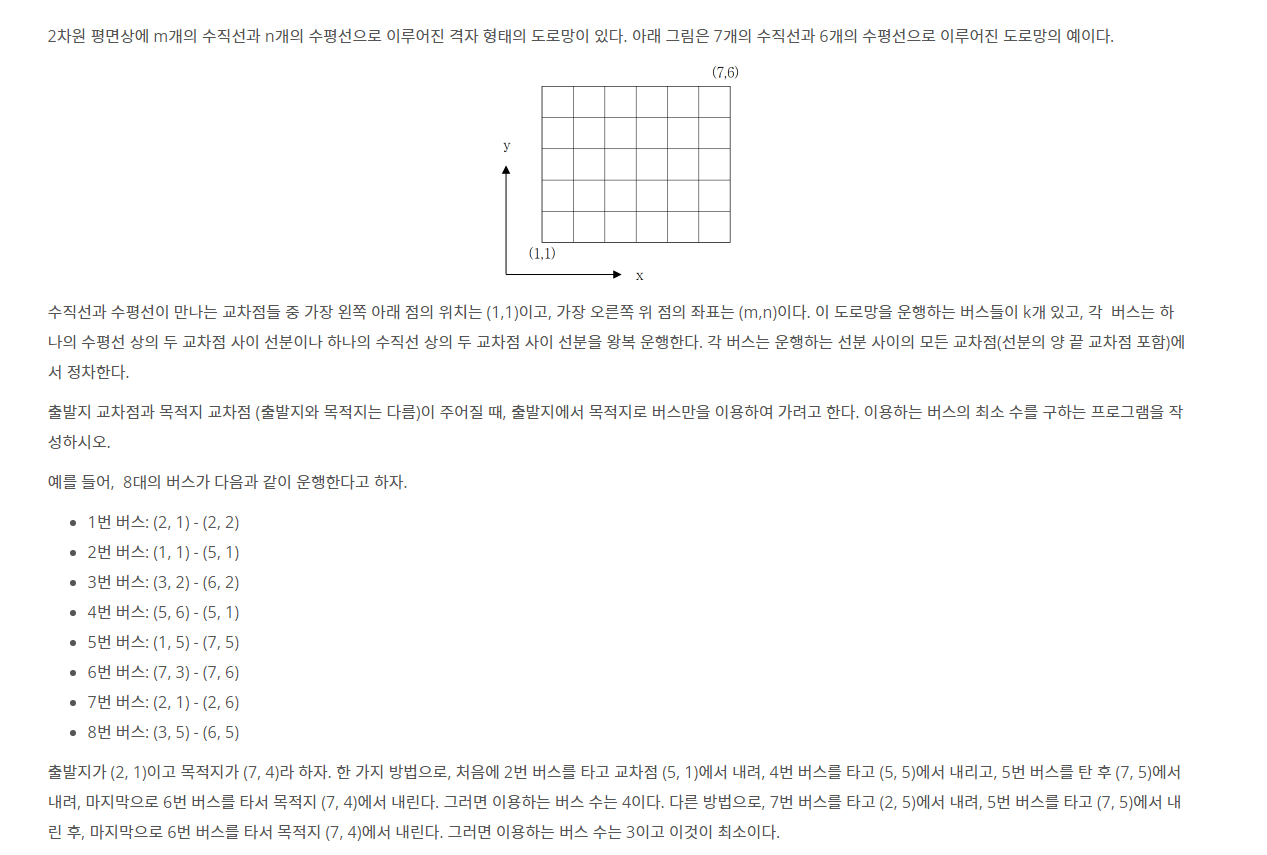
from collections import deque
n, m = map(int, input().split())
k = int(input())
visit = [False] * (k + 1)
horizon_bus = []
vertical_bus = []
bus = [[0]]
isHorizon = [False] * (k + 1)
for _ in range(k):
b, x1, y1, x2, y2 = list(map(int, input().split()))
# 크기가 뒤죽박죽이라 오름차순으로 나열
if x1 > x2:
x2, x1 = x1, x2
if y1 > y2:
y2, y1 = y1, y2
if x1 - x2:
vertical_bus.append([b, y1, x1, x2])
else:
horizon_bus.append([b, x1, y1, y2])
isHorizon[b] = True
bus.append([b, x1, y1, x2, y2])
# 버스 번호가 무작위라 정렬
bus.sort(key=lambda x: x[0])
dest = list(map(int, input().split()))
start = dest[:2]
end = dest[2:]
queue = deque()
answer = 0
for index, y, x1, x2 in vertical_bus:
# 시작지점과 y 가 같고 시작지점 x가 버스에 포함되어있으면 추가
if start[1] == y and (x1 <= start[0] <= x2):
queue.append([1, index, start[0], start[1]])
visit[index] = True
for index, x, y1, y2 in horizon_bus:
# 시작지점과 x 가 같고 시작지점 y가 버스에 포함되어있으면 추가
if start[0] == x and (y1 <= start[1] <= y2):
queue.append([1, index, start[0], start[1]])
visit[index] = True
def solve():
while queue:
count, thisBus, thisX, thisY = queue.popleft()
thisBusData = bus[thisBus]
# 현재 버스에서 도착지점까지 갈 수 있는지 검증한다. 만약 갈수 있다면 현재까지의 버스 방문회수를 리턴하고 종료
if isHorizon[thisBus]:
if thisX == end[0] and thisBusData[2] <= end[1] <= thisBusData[4]:
return count
else:
if thisY == end[1] and thisBusData[1] <= end[0] <= thisBusData[3]:
return count
# 다음 버스가 수평으로 가는 경우
for nextBus, nextY, nextX1, nextX2 in vertical_bus:
if visit[nextBus]:
continue
# 타고온 버스가 수직일 경우 교차점이 생기는지 조사한다.
if isHorizon[thisBus]:
if (nextX1 <= thisX <= nextX2) and (thisBusData[2] <= nextY <= thisBusData[4]):
queue.append([count + 1, nextBus, thisX, nextY])
visit[nextBus] = True
# 같은 수평 수평일 경우 한 버스랑 다른 버스랑 겹치면 큐에 더하고 아예 다른 버스에 포함이 되는 버스면 추가하지 않는다.
else:
if thisY == nextY and ((thisBusData[3] <= nextX1) != (thisBusData[1] <= nextX2)):
queue.append([count + 1, nextBus, nextX1, thisY])
visit[nextBus] = True
# 다음 버스가 수직으로 가는 경우
for nextBus, nextX, nextY1, nextY2 in horizon_bus:
if visit[nextBus]:
continue
# 타고온 버스가 수평일 경우 교차점이 생기는지 조사한다.
if not isHorizon[thisBus]:
if (nextY1 <= thisY <= nextY2) and (thisBusData[1] <= nextX <= thisBusData[3]):
queue.append([count + 1, nextBus, nextX, thisY])
visit[nextBus] = True
# 같은 수직 수직일 경우 한 버스랑 다른 버스랑 겹치면 큐에 더하고 아예 다른 버스에 포함이 되는 버스면 추가하지 않는다.
else:
if thisX == nextX and ((thisBusData[4] <= nextY1) != (thisBusData[2] <= nextY2)):
queue.append([count + 1, nextBus, thisX, nextY1])
visit[nextBus] = True
print(solve())
먼저 처음 시작 지점에서 갈 수 있는 버스 노선들을 전부 큐에더가 저장을 한다.
버스 시작점과 종착점 사이에 시작 지점이 있으면 큐에다가 저장
이제 큐를 돌면서 순회를 하게 되는데
- 지금 내가 탄 버스가 수평일 경우 :
- 다음 버스가 수직일 경우 :
두 선분을 비교해서 교차점이 생기는지 확인을 한다.
교차점이 생기고 방문하지 않은 버스라면 큐에다가 저장 - 다음 버스가 수평일 경우 :
두 선분을 비교해서 겹치는 부분이 있는지 확인 한다.
한 선분이 아예 다른 선분안에 포함되어 있으면 큐에 저장을 하지 않는다
- 다음 버스가 수직일 경우 :
지금 내가 탄 버스가 수직일 경우도 똑같이 수평 수직만 바꾸어서 똑같은 알고리즘으로 수행하면된다.
알고리즘 자체는 3분만에 떠올랐는데 코드 짜고 디버그 하느라 시간이 꽤 오래걸렸다.
대략 한 두시간 정도?
